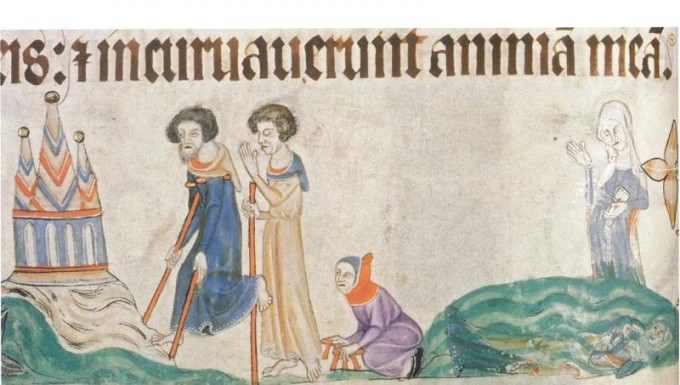Most of the portrayals of disabled people from the 10th to end of 13th Century are to be found in illustrated hand coloured and drawn manuscripts, miniature paintings from greater Persia and stain glassed windows produced by unknown artisans or artists.. They are mainly moral tales and tales of miracles deriving from the religious stories of Judaism, Christianity and Islam.
St Gulthric expels a demon 1210, England. A acknowledgement of mental health ?
Christ heals a paralytic at pool at Bethesda-‘Take up thy bed and walk’ and Christ heals a blind man
Syrian Lectionary northern Iraq 1256-20
A paralytic healed by Cuthburt’s Shrine and a baby and youth cured by relics (a hair) of St Cuthbert. Bede’s Life of Saint Cuthburt ,Durham 1200.
Often disabled pilgrims were portrayed on their way to a holly shrine for a cure.
Pilgrims, 2 lame and one blind, on their way to Mount St.Michel in France. The Luttrel Psalter Lincoln 1325
Sometimes just a thorn from Christs Crown, nails from his cross or his winding sheet-the holy grail were attributed with cures.
The holy grail is carried to Sarras(Jerusalam) by knoights assisted by a lame man cured by Galahad The Quest for the Holy Grail France 1316
Manuscript illustrations give us glimpse into the life of disabled people during this period
 Medieval crutches July 18 Hermann of Reichenau 1013-1054
Medieval crutches July 18 Hermann of Reichenau 1013-1054
Disabled people as figures of fun. Harvesting
Pitiable
Fighter with a crutch!
Luttrell Psalter 1325. In medieval England, the ‘leprechaun’, the ‘blynde’, the ‘dumbe’, the ‘deaff’, the ‘natural fool’, the ‘creple’, the ‘lame’ and the ‘lunatick’ were a highly visible presence in Everyday life and reflected in Manuscript illustrations.
Stained Glass windows in Cathedrals and Churches sent out similar messages.
William heals a blind woman. York Minster
A-stained-glass-window-depicting-jesus-curing-the-man-with-palsy-church Church of Christ the Consoler, Skelton Cum Newby
Timur the Lame or Tamberlain featured in of minatures. The unlikely combination of a war leader who captured a sizeable central Asian empire whilst bein disabled from injuries in his leag and hand.
Tamberlain in Anatolia. Tamerlane who won the Ankara war against the Ottoman Sultan Bayezid I in July 28, 1402
He did not immediately left Anatolia and stayed there for approximately one year. http://www.bbc.co.uk/news/magazine-20538810
A fallen rider revived by St Dominic. The caption says he broke his neck, 1330, Yates Thompson MS, England
Lame Tamerlane imprisoned and humiliated the Ottoman Sultan Bayezid.
Timur defeats the Sultan of Delhi
The brazen serpent. Hebrew Northern France 1278-98
Source Marvellous to Behold Miracles in Medieval Manuscripts Deirdre Jackson 2007 The British Library





















